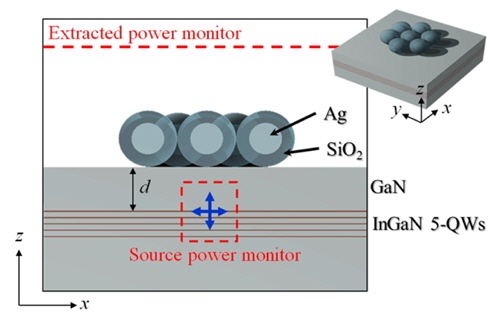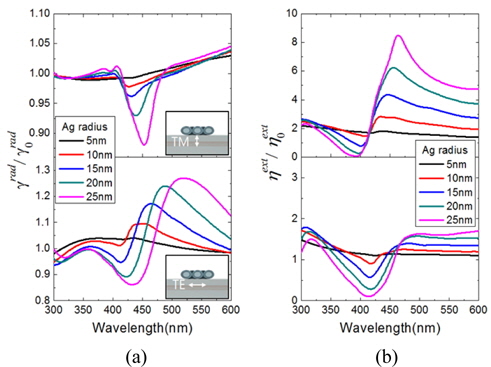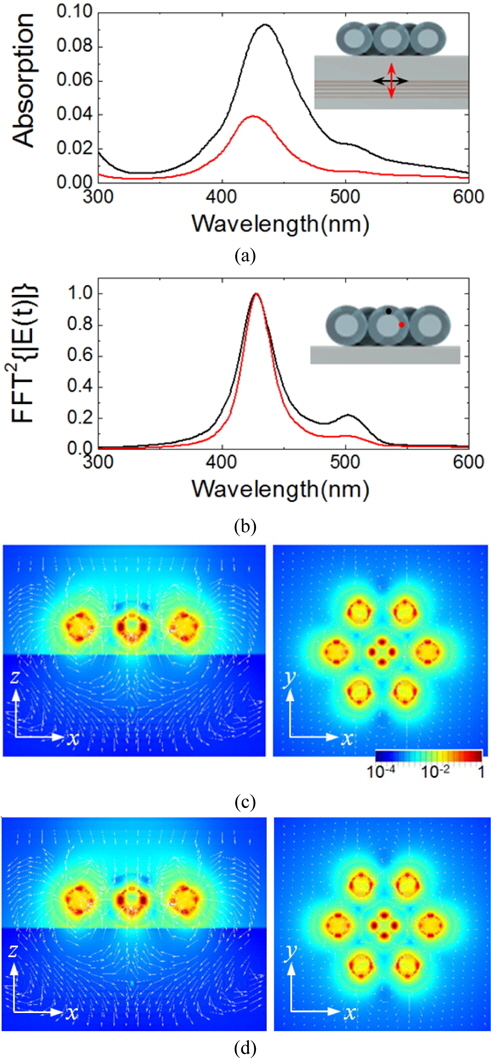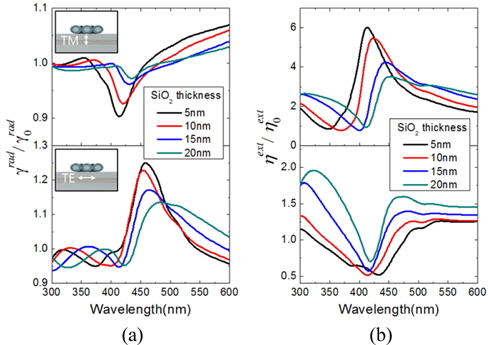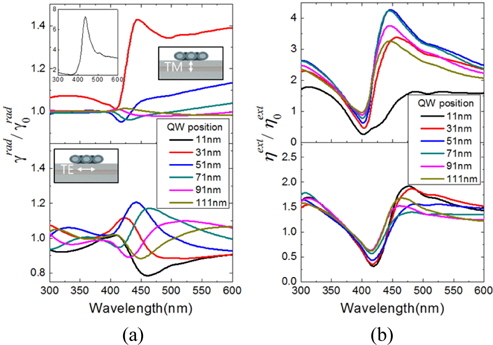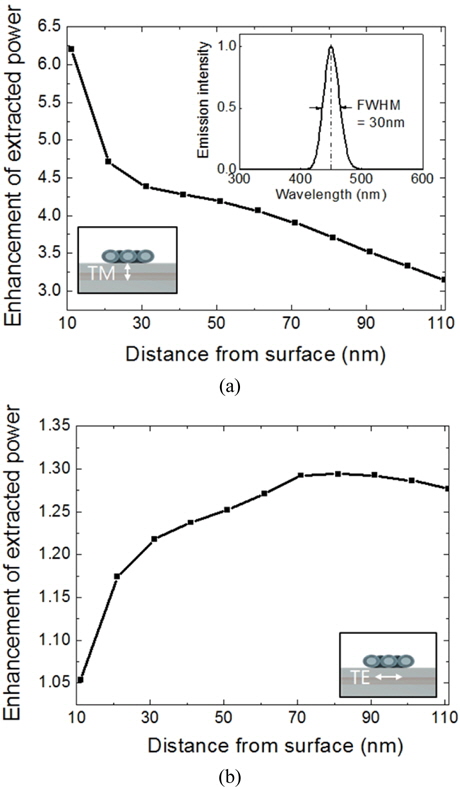



GaN based solid-state light emitting diodes (LEDs) are widely attractive as an alternative energy saving lighting device because of high efficient light emission [1, 2]. The external quantum efficiency (EQE) of light emission is given by internal quantum efficiency (IQE) and light extraction efficiency (LEE). For achieving high-efficiency LEDs, both of IQE and LEE should be high enough. The IQE is usually limited by the quality of an active medium such as an InGaN quantum well (QW), and LEE is limited by total internal reflection (TIR) in high index contrast between the semiconductor and surrounding material. Recently, the high IQE of InGaN/GaN blue LEDs was achieved with the help of rapid development of semiconductor growth technology [3, 4]. The LEE was also dramatically improved by introducing the surface patterning in both the top and bottom surfaces [5, 6]. However, in green LEDs, the IQE is still very low because of the poor crystal properties such as In dislocation and strong piezo-electric effect [7]. Moreover, in the deep UV regime, there are no transparent electrodes and encapsulation materials, leading to very poor LEE [8].
Since pioneer work in early twenty-first century, surfaceplasmon( SP)-coupled light emitting diodes (LEDs) have been widely studied theoretically and experimentally in order to improve both IQE and LEE, especially in green LEDs [9-13]. The mechanism of IQE enhancement in SP LEDs is the resonant energy transfer from the carrier recombination in QWs to the SP mode at the metal structure, and the outcoupling of the SP mode into the radiation mode. Hence, the efficient QW-SP coupling increases the spontaneous emission (SE) rate, while the nonradiative process is reduced simultaneously. In addition, the metallic nanoparticle (NP) has very large scattering cross section to extract the light outside materials to overcome TIR. For satisfying the industrial demand, it is necessary to achieve not only the high emission efficiency but also no degradation of device performance. However, the problem in Ag NP coated LEDs is an easy oxidation of Ag which induces significant absorption of the SP mode before transition to the radiation mode. It was reported that Ag/SiO2 core-shell (CS) coated LEDs had more consistent emission efficiency than Ag NP coated LEDs [14].
Generally, the SE rate of a dipole near a metallic structure strongly depends on the radiation direction [15]. Moreover, the emitted light from the GaN based LEDs is partially polarized according to the growth direction and the aluminum content [16-19]. Recently, researchers have paid attention to polarization of light emission in SP-coupled LEDs. Most reports are related to the Ag NP buried in the p-GaN layer, where the enhancement of the radiation power of the dipole near the Ag NP is dramatically changed by the direction of the dipole radiation [20-22]. However, the Ag NP embedded structure has several issues for the real LED device because of the irregular Ag NP size caused by the high temperature during the epitaxial process and the degradation of the crystal quality due to the Ag NPs. Moreover, there was no mention about the LEE enhancement because the structure does not include air-GaN boundary structure. One paper reported that the total photoluminescence (PL) decreases significantly by localized SP (LSP) resonant dissipation even though there is large enhancement of photoluminescence (PL) decay rate by the efficient LSP-QW coupling [23]. In this paper, we numerically study polarization dependent enhancement both of the SE rate and the LEE in a closely packed seven Ag/SiO2 CS NP coated InGaN/GaN LEDs by changing the Ag size, the thickness of SiO2, and the distance of the QWs from the surface. Finally, we suggested the optimum position of the QW in blue InGaN/GaN LEDs with Ag/SiO2 CS NPs for practical application.
Recently, the dipole radiation property near Ag NP was studied by semi-classical analysis [20, 21]. According to the reports, the SP mode could be analyzed by the theoretical model when the Ag NPs are in homogeneous media. However, it is hard to solve the optical property of Ag/SiO2 CS NP coated InGaN/GaN LEDs by the semi-classical approach because of breaking the azimuthal symmetry of the structure. In this paper, we analyze light emission properties by a full three-dimensional (3-D) finite-difference time-domain (FDTD) method [24, 25].
The schematic cross section of the LED structure being considered is shown in Fig. 1. The closely packed seven identical Ag/SiO2 CS NPs lie on the p-GaN surface. The five InGaN QWs are positioned below the 70-nm-thick p-GaN layer. Each QW has the same thickness with 2 nm and the barrier between QWs is 8 nm. The refractive indices of InGaN and GaN are 2.7 and 2.46, respectively. Here, we use the perfectly matched layer (PML) absorbing boundary to realize the infinite-size space. The spatial nonuniform- grid FDTD method is used for saving the computational memory. Note that the minimum grid size is fixed as 1 nm, which is an adequate size to resolve the strongly localized field distribution in consideration of limited computational power. The dipole polarized parallel to the surface (TE-polarized dipole) or normal to the surface (TMpolarized dipole) is launched at the center of the 2-nm-thick InGaN QW. The lateral position of the dipole source is fixed at the center of the central Ag/SiO2 CS NP. The total radiation power is obtained by integrating the power flux through the monitor box surrounding the dipole source. And the extracted power is obtained by integrating the power flux through the monitor plane at 135 nm above the p-GaN surface, which corresponds around a 74-degree solid angle. The enhancement of the SE rate (
3.1. Dependence On The Ag Size
The LSP resonance is strongly affected by the size, the shape and the environmental materials of the metal NP [27]. Therefore, in order to improve the emission efficiency of the LEDs, the LSP resonance should be spectrally close to the emission wavelength. First, we investigated the Ag size dependence of the SE rate and the LEE with different dipole polarizations. Here, the thickness of SiO2 is fixed at 20 nm, and the source distance from the surface,
Figure 2(a) shows
For the further understanding of the SE rate change, we considered a simple model: a dipole emitter near a metal sphere in a homogeneous medium. This problem has an exact analytical solution based on Mie scattering theory [28-30]. The presence of the metallic NP near a dipole emitter introduces an additional nonradiative decay channel which depends only on the material property of the metal. Therefore, as the size of Ag increases, the nonradiative decay rate is enhanced, while there is no significant polarization dependence and no wavelength shift [31]. This is matched with the tendency of the dip in spectra of
The strength of the resonant coupling is determined by how the dipole emitter is close to the LSP mode, spatially and spectrally. We also calculated the absorption and resonance behaviors at Ag/SiO2 CS NPs in both the TM-polarized dipole and the TE-polarized dipole. Figure 3(a) shows the absorption spectra when the radius of Ag is 15 nm. The absorption spectrum is calculated by subtracting the Poynting flux from the total radiation power of the dipole source. Here, the boundary of the calculation domain with the exception of the PML layer is used as the integral surface of the Poynting flux, which should be far from a dipole source and the LSP mode at the Ag/SiO2 CS NPs. Both the TM-polarized dipole and the TE-polarized dipole have a similar absorption spectrum. The difference of the absorption intensity between the TM-polarized dipole and the TE-polarized dipole is caused by different radiation direction. Figure 3 (b) shows the LSP resonance spectra at Ag/SiO2 CS NPs when the dipole source is launched at 71 nm below the GaN surface. Note that the resonance spectrum is obtained by the discrete Fourier transform of the time-varying electric field at the maximum intensity positions after the dipole source radiation which are marked as the red dot (the left edge of the center Ag) for the TM-polarized dipole and the black dot (the top of the center Ag) for the TE-polarized dipole, as shown in the inset of Fig. 3(b). The resonance spectra look very similar to the absorption spectra. This implies that the absorption of the radiative light is caused by the ohmic loss after coupling with the LSP modes in Ag/SiO2 CS NPs. Two LSP resonance peaks are found at 428 nm, and 503 nm regardless of the dipole direction. Figure 3(c) show the cut-views of the electric field distribution of the LSP mode at 428 nm in the TM-polarized dipole. According to the xz cut-view, the electric field has a symmetric distribution along the z-axis. In addition, from the xy cut-view, the electric field near the center of Ag/SiO2 CS NP is oscillated in the radial direction. In case of the LSP resonance in the TE-polarized dipole, the direction of the electric field near the left and right Ag/SiO2 is along the x-direction shown in the left of Fig. 3 (d). Moreover, the electric field intensity near three Ag/SiO2 CS NPs on the x-axis is stronger than the intensity near the others, as shown in the xy cut-view. From these facts, the LSP resonance in the TE-polarized dipole is the coupled x-dipole modes at Ag/SiO2 CS NPs on the x-axis. In the TM resonance, the intensity at the GaN layer underneath the center Ag/SiO2 NP is stronger than that in the TE resonance. Hence, the resonant energy transfer between the QW and the LSP in the TM-polarized dipole is more efficient than in the TE-polarized dipole. We will discuss the distance dependence of
3.2. Dependence On The SiO2-shell Thickness
Usually, the Ag NPs are easily oxidized at the surface as time goes on. Therefore, the LSP absorption in the Ag NP is dramatically enhanced by the ohmic loss in the Ag surface [14]. In order to avoid the absorption in the Ag surface, the Ag/SiO2 CS structure was suggested for the efficient and reliable SP LED performance. However, if the SiO2 shell is too thick,
Figure 4(a) shows the spectra of
3.3. Dependence On The Quantum-well Position
The most important parameter for the efficient QW-SP coupling is the distance from the metallic NPs to the emitter [10, 30-31]. If the dipole emitter is close to the NPs, the quantum efficiency increases because of the stronger QW-SP coupling and light scattering. However, if the dipole emitter is very close, about a few nm, the quantum yield decreases rapidly, hence the quantum efficiency decreases by the quenching effect [28, 31]. In this section, we systematically studied the dependence of the quantum efficiency on the distance between QWs and Ag/SiO2 CS NPs according to the dipole direction. Here, we fixed the radius of Ag and the thickness of SiO2 as 15 nm and 20 nm, respectively.
Figure 5(a) shows the dependence of
This phenomenon could be understood by using the electrostatic image theory [28, 33]. According to the method of image charges, the image dipole moment,
Figure 5(b) shows the dependence of
According to these results, as
We numerically investigated polarization-dependent SE rate and LEE in LSP-coupled LEDs. The closely packed seven Ag/SiO2 CS NPs lie on top of the GaN surface for LSP coupling with a radiated dipole. According to the dipole direction, both the SE rate and the LEE are significantly modified by LSP effect at Ag/SiO2 CS NPs when the size of Ag, the thickness of SiO2, and the position of the dipole source are varied. In the dipole oscillating parallel to the surface, the SE rate is modified by strong near-field energy coupling and the interference effect between a real dipole and an induced dipole at the Ag, and the LEE is changed due to light scattering and ohmic loss at Ag/SiO2 CS NPs. In the dipole oscillating normal to the surface, the SE rate is dramatically enhanced by extremely strong near-field coupling only when the dipole is near the Ag. And the LEE is significantly enhanced because the light mostly guided in the substrate is extracted by scattering with LSP modes. Finally we suggested the optimum QW position for maximizing extracted power in blue InGaN/GaN LEDs at each dipole direction. In TM polarization, the extracted power keeps increasing as the QW is close to the Ag/SiO2 CS NPs. However, in TE polarization, the extracted power is maximized about 1.3 times higher than that in the blue LED without Ag/SiO2 CS NPs when the QW is near 80 nm from the surface. We believe that these results help to optimize the nitride-based LSP-LED structures with different growth directions.


